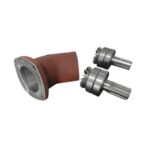
Introduction
In the realm of plastic injection molding, the efficiency and quality of the process rely heavily on precise temperature control. Mold temperature controllers play a pivotal role in regulating the temperature of molds, ensuring optimal conditions for the production of high-quality plastic components.
This comprehensive guide explores everything you need to know about mold temperature controllers, from their functions and types to their benefits and best practices.
Functions of Mold Temperature Controllers
Mold temperature controllers serve multiple essential functions in the plastic injection molding process, including:
- Temperature Regulation: Maintaining consistent temperatures within the mold cavity and the cooling channels to prevent warping, shrinkage, and defects in the molded parts.
- Heat Transfer: Facilitating efficient heat transfer between the mold and the cooling medium (usually water or oil) to accelerate the cooling process and reduce cycle times.
- Precision Control: Providing precise temperature control with programmable settings to accommodate different materials, molds, and production requirements.
- Energy Efficiency: Optimizing energy consumption by minimizing heat loss and ensuring uniform temperature distribution throughout the mold.


Types of Mold Temperature Controllers
Mold temperature controllers come in various types, each offering distinct features and advantages:
- Water Temperature Controllers: Utilize water as the cooling medium, offering fast heat transfer and precise temperature control. Ideal for applications requiring rapid cooling and high accuracy.
- Oil Temperature Controllers: Employ thermal oil for heat transfer, offering excellent thermal stability and uniform temperature distribution. Suitable for high-temperature molding processes and materials with stringent temperature requirements.
- Dual-zone Temperature Controllers: Feature multiple heating and cooling zones to accommodate complex molds with different temperature requirements for various sections.
- Portable Temperature Controllers: Compact and portable units designed for flexibility and mobility, allowing for easy integration into different molding setups and production environments.
Benefits of Using Mold Temperature Controllers
Integrating mold temperature controllers into plastic injection molding processes offers several key benefits:
- Improved Part Quality: Consistent temperature control minimizes variations in part dimensions, surface finish, and mechanical properties, resulting in higher-quality molded parts.
- Reduced Cycle Times: Faster cooling rates facilitated by temperature controllers lead to shorter cycle times, increasing productivity and throughput.
- Cost Savings: Optimized energy consumption and reduced scrap rates contribute to overall cost savings in production.
- Extended Tool Life: Controlled temperature environments mitigate thermal stresses on molds, prolonging tool life and reducing maintenance costs.
- Process Stability: Precise temperature control enhances process repeatability and stability, reducing the likelihood of defects and rework.
Best Practices for Using Mold Temperature Controllers
To maximize the benefits of mold temperature controllers, consider the following best practices:
- Proper Sizing: Select temperature controllers with adequate heating and cooling capacities to match the requirements of the molding process and the size of the mold.
- Regular Maintenance: Perform routine inspections, cleaning, and maintenance to ensure optimal performance and longevity of temperature control equipment.
- Calibration and Monitoring: Regularly calibrate temperature controllers and implement real-time monitoring systems to verify temperature accuracy and detect anomalies promptly.
- Optimized Settings: Experiment with different temperature settings and cooling strategies to find the optimal parameters for specific materials, molds, and part geometries.
- Operator Training: Provide comprehensive training to operators on the proper use, maintenance, and troubleshooting of mold temperature controllers to minimize errors and downtime.
Conclusion
In conclusion, mold temperature controllers are indispensable tools in plastic injection molding operations, offering precise temperature regulation, improved part quality, and increased productivity.
By understanding their functions, types, benefits, and best practices, manufacturers can optimize their molding processes and achieve consistent, high-quality results.
Drop me an email with your ideas, and I’ll get back to you swiftly!



















